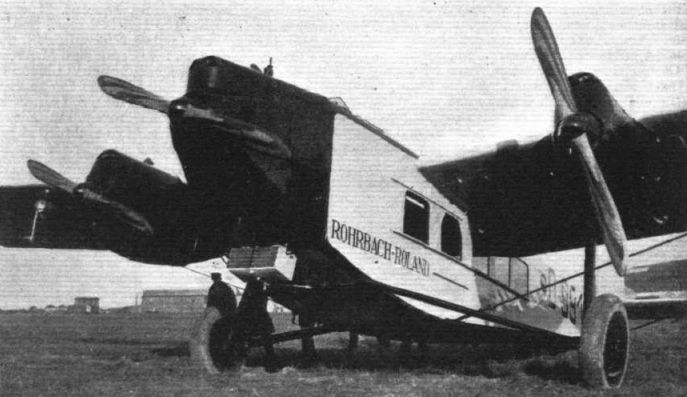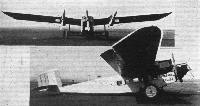
Варианты
- Zeppelin-Staaken - E.4/20 - 1920 - Германия
- Rohrbach - Ro.VIII Roland - 1926 - Германия
Rohrbach. Самолеты
<...>
Самым значительным самолетом Рорбаха стал сухопутный Ro VIII Roland, спроектированный на основе четырехмоторного Zeppelin-Staaken E.4/20 (главный конструктор Рорбах), выполнившего первый полет в 1920 году, но разобранного по требованию победителей-союзников.
Самолет Ro VIII представлял собой моноплан с подкосным полуконсольным крылом. Два члена экипажа размещены в открытой кабине бок о бок, сзади и ниже кабины летчиков расположена закрытая кабина для десяти пассажиров. Силовая установка включала три мотора BMW IV или Va мощностью по 320 л. с. или 360 л. с., соответственно.
На варианте Ro VIIIa Roland II были установлены моторы BMW Va мощностью по 380 л.с. Roland был способен набирать высоту до 5000 м и выполнять полеты за облаками. Авиакомпания "Deutsche Luft Hansa" (DLH) с мая 1927 года использовала самолет для экспериментальных полетов через Альпы из Мюнхена в Милан, хотя машина не имела адекватного для таких перелетов приборного оборудования и радиостанции.
В 1927-1929 годах было построено девять гражданских авиалайнеров для DLH, которые использовались на линии Берлин - Лондон с посадкой в Амстердаме.
Несколько Roland взяла в аренду испанская "Iberia", после завершения коммерческой эксплуатации они были переданы в начале 1930-х годов DVS (Deutsche Verkehrsfliegerschule, германской школе летчиков транспортной авиации).
<...>
Описание:
- Rohrbach. Самолеты
- Flight, May 1929
THE ROHRBACH "ROLAND II”
Фотографии
-
Мировая Авиация 224
Регистрационный номер: D-1756 Этот самолет D-1756 - Roland II - под наименованием "Rolandseck" использовался "Deutsche Luft Hansa" в конце 1920-х - начале 1930-х годов. В 1934 году DLH передала самолет в школу транспортной авиации (DVS), где он получил новую регистрацию D-ANAX.
-
Flight 1926-10 / Flight
Регистрационный номер: D-991 [4] The Rohrbach "Roland": Close-up view showing the three engines, the undercarriage, &c. Note the single "funk-wire" on each side. The engines are carefully disguised, but are obviously 6-cylinder verticals. The saloon has accommodation for ten passengers.
-
Aeroplane Monthly 1984-11 / J.Stroud - Wings of Peace
Регистрационный номер: D-991 [4] Early view of Rohrbach Ro VIII Roland D-991 with the window frames apparently painted on the metal skin.
-
Flight 1926-10 / Flight
Регистрационный номер: D-991 [4] The Rohrbach "Roland": At the moment, when it is rumoured that the Beardmore works at Dalmuir have under construction a large three-engined monoplane, this photograph of the Rohrbach "Roland" is of interest. It would appear that in this machine also Dr. Rohrbach has "practised what he preaches" concerning high wing loading. Needless to say, the machine is of all-metal construction.
-
Aeroplane Monthly 1984-11 / J.Stroud - Wings of Peace
Регистрационный номер: D-991 [4] Roland D-991 landing at Croydon
-
Aeroplane Monthly 1984-11 / J.Stroud - Wings of Peace
Регистрационный номер: D-999 [3] An early picture of D-999, with centre engine radiator in line with the main undercarriage.
-
Flight 1927-02 / Flight
Регистрационный номер: D-999 [3] A GERMAN RECORD-BREAKER: The Rohrbach-Roland three-engined metal monoplane (of Luft Hansa) on which the German pilot Steindorf beat five world's records on February 4 at Staaken. With a load of 1,000 kg. (2,205 lbs.) he (attained a speed of 165 k.p.h. (102-5 m.p.h.) over the 500 kms. (310-7 miles), beating the last record of 163-076 k.p.h. (101-1 m.p.h.) held by Mittelholzer (Switzerland). With 2,000 kg. (4,410 lbs.) load he beat four more records: duration, 4 hrs. 18 mins.; distance, 600 kms. (372-8 miles); speed, 100 kms.- 173 k.p.h. (107-5 m.p.h.); 500 kms. - 165 k.p.h. (102-5 m.p.h.). The four original records held by de Lamothe and Bajac, were respectively, 4 hrs. 4 mins. 13 1/5 secs.; 500 kms.; 150-3 k.p.h. (93-18 m.p.h.); and 147-511 k.p.h. (91-4 m.p.h.).
.91 -
Aeroplane Monthly 1984-11 / J.Stroud - Wings of Peace
Регистрационный номер: D-1124 Roland D-1124 was built tn 1927 and delivered to Luft Hansa in 1928.
-
Мировая Авиация 224
Регистрационный номер: D-1280 Самолет Ro VIII Roland I (регистрация D-1280, №35) под наименованием "Feldberg" до 1934 года эксплуатировался в "Deutsche Luft Hansa". После постройки шести Ro VIII собрали еще три самолета варианта Ro VIIIa с усиленным фюзеляжем и более мощными моторами BMW V.
D-1280 Feldberg with crude metal propellers on all engines. -
Air Pictorial 1986-01 / J.Stroud - Air Affairs
Регистрационный номер: D-1297 The Rohrbach Roland's wing dihedral is proving popular with builders of flying models. Will they retain the belt-and-braces safety cable bracing to the cantilever wing? Seen here is D-1297 "Wasserkuppe" with a mixture of wood and metal airscrews
-
Air Pictorial 1956-06 / Photos by request
Регистрационный номер: D-1327 ROHRBACH Ro VIII ROLAND: A common sight at Croydon Airport in the 1930s, the German Rohrbach Ro VIII Roland was produced in two variants. The earlier version (see photo) had an open crew cockpit, whereas the later version - from D-1692 onwards - had an enclosed cabin, and was known as the Roland II. Power for the Roland I was three 240-h.p. BMW IVs, while that for the Roland II was three 320-h.p. BMW Va's or 310-h.p. Junkers L-5. Span 86 ft . 34- in .; length 53 ft . 10 in. Total weight (Roland II) 16,760 lb. for maximum speed of 131 m.p.h . Note emergency magnesium flares under wings.
-
Flight 1927-06 / Flight
RECORD BREAKERS: The upper photograph, and that on the left, show the Rohrbach "Roland" three-engined monoplane which recently established world's records over 1,000 km. with useful loads of 1,000 kg. and 2,000 kg. The speed was 196-7 km./h. (122 m.p.h.). In the photograph on the right Chamberlin and Levine are seen during a visit to the Rohrbach works, examining the construction of a Rohrbach all-metal machine.
-
Aeroplane Monthly 1984-11 / J.Stroud - Wings of Peace
Регистрационный номер: D-999 [3] Roland D-999 Watzmann after being brought to Ro VIIIa standard with enclosed cockpit and metal propellers.
-
Мировая Авиация 224
В 1926-1932 годах "Rohrbach" построила 18 Roland I и II (на фотографии). В конструкцию Roland II внесли ряд изменений, установили новое крыло и изменили интерьер кабины экипажа.
-
Flight 1929-05 / Flight
THE NEW ROHRBACH "ROLAND": Two views of the improved machine recently produced. A larger cabin and cockpit and better engine installation are features of the latest type.
-
Aeroplane Monthly 1984-11 / J.Stroud - Wings of Peace
The prototype Roland II with high-mounted wing, fully-enclosed crew cabin and wooden propellers. The radiators are in the extended position.
-
Aeroplane Monthly 1984-11 / J.Stroud - Wings of Peace
Регистрационный номер: D-1692 The Rohrbach Ro VIII Roland II had enclosed cockpits and a trio of BMW Va engines. This example, D-1692 Stolzenfels, the first of nine Rohrbach Roland IIs, all of which were delivered to Luft Hansa in 1929, later became D-ARAF.
-
Aeroplane Monthly 1984-11 / J.Stroud - Wings of Peace
Регистрационный номер: D-1710 D-1710 Rheinstein, a Roland II, with main-wheel spats.
-
Aeroplane Monthly 1984-11 / J.Stroud - Wings of Peace
Регистрационный номер: D-1745 [2] Roland II D-1745 Siegburg still with wooden propeller on the centre engine. The much reduced dihedral is apparent.
-
Aeroplane Monthly 1977-01 / M.Langley - Fifty years in aviation
A typical view of Croydon in the 1930s, with the famous terminal building dominating the scene. On the apron, left to right, are a Fokker F.III, Rohrbach Roland, Liore et Olivier 21, Handley Page W8b and Handley Page W10.
Другие самолёты на фотографии: Fokker F.III - Нидерланды - 1921Handley Page H.P.18 (W.8) / H.P.30 (W.10) - Великобритания - 1919Liore et Olivier LeO 21 - Франция - 1926
-
Aeroplane Monthly 1984-11 / J.Stroud - Wings of Peace
The open cockpit of the Roland I.
-
Aeroplane Monthly 1984-11 / J.Stroud - Wings of Peace
Регистрационный номер: D-1745 [2] KEITH WOODCOCK'S painting illustrates Rohrbach Roland D-1745 Siegburg of Luft Hansa.
-
Flight 1929-01 / Flight Advertisements
Few types of all-metal Multi-engined Aircraft are able to continue Flight with one Engine out of action. The Rohrbach Roland is capable of doing so.
- Фотографии






















